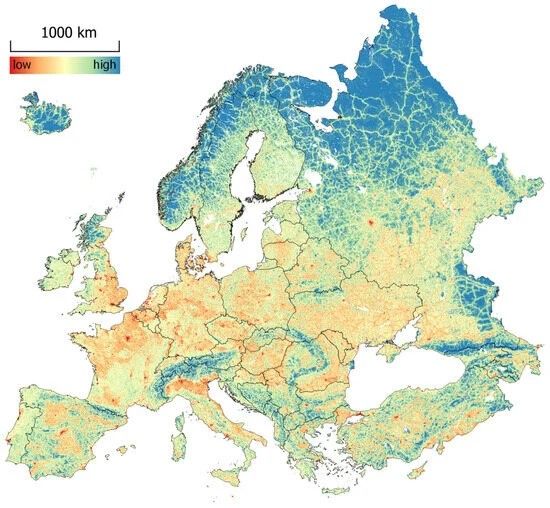Mapping Europe’s wilderness to help preserve it

A new paper makes the case for an updated Wilderness Quality Index (WQI) across Europe, including non-EU states, to ensure precious wild landscapes and ecosystems are protected.
The paper, titled ‘Developing a Wilderness Quality Index for Continental Europe’ is published in the journal Land.
It was co-authored by Steve Carver (Wildland Research Institute, School of Geography) with Iurii Strus (Frankfurt Zoological Society) in Kyiv.
They used Google Earth Engine (GEE) and new datasets to expand and update the existing Wilderness Quality map of Europe, naming their version WQI 2.0.
They added maps of non-EU states such as Armenia, Azerbaijan, Belarus, Georgia, Moldova, Russia (the European part) and Ukraine.
What is a Wilderness Quality Index?
The European Environment Agency was mandated to map existing wilderness areas in Europe following the Resolution on Wilderness in Europe (2009), alongside other actions to define, understand and protect wildlands.
Wilderness – typically remote, minimally modified landscapes – is essential for healthy biodiversity and ecosystems. It supports endangered species and offers opportunities for research, education and human wellbeing.
Maps of the wilderness are essential to develop effective policies on its protection and restoration, including rewilding initiatives.
They can be used to see which areas fall outside protected boundaries and identify those at risk of degradation.
View the 2011 Wilderness Quality Indexes by the European Environment Agency.
Conservation must be a priority
WQI 2.0 shows many similarities to the existing data in WQI 1.0, highlighting the accuracy of their approach to mapping.
However, the new and updated information allows researchers to monitor degradation and conservation over time and across a larger area of land.
“Advancements in computing technologies and data accessibility have revolutionised research in this field,” the researchers write.
“However, the escalating human impact on wilderness highlights the urgency for both research and political action.”
WQI 2.0 provides a basis for an informed, coordinated European policy on wilderness protection across EU and non-EU countries.
The paper highlights the importance of specific areas to meet commitments from the COP15 Kunming-Montreal Agreement and Convention on Biological Diversity (CBD) targets, which aim to protect 30% of land, lands, fresh waters and oceans through conservation by 2030.

Wilderness quality index map WQI 2.0, showing 'low' to 'high' levels of wilderness.
Strus, I.; Carver, S. Developing a Wilderness Quality Index for Continental Europe. Land 2024, 13, 428. https://doi.org/10.3390/land13040428. CC BY 4.0.
Professor Steve Carver said: “Wilderness protection is listed first in the list of priorities in the CBD's post-2020 biodiversity framework because biodiversity tends to be highest in wilder areas. If we are to protect these areas, we need to know where they are.
“Our maps provide a stepping-off point for mapping the top 30% of areas and compare these against existing protected area networks. If an area is in the top 30% wildest areas but not legally protected, we can use the maps to define boundaries for a new protected area.”
Local programmes in Scotland, France, Iceland and Germany support the creation of wilderness maps. The authors encourage the creation of similar programmes across Europe.
Governments, policymakers, researchers and conservation organisations can use the updated map to identify intact wildlands that can be preserved, evaluate those that require restoration and ensure wilderness protection. WQI 2.0 has already been used by Wild Europe.
The authors write that this is “a priority goal in addressing the linked climate and biodiversity crises.” They will present their work at the 12th World Wilderness Congress (WILD12) in Dakota in August 2024.




